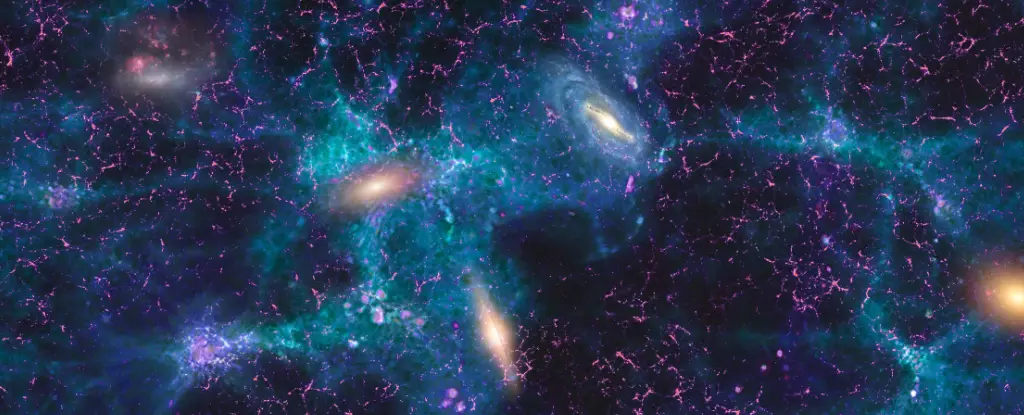The cosmos is an enigmatic expanse, perpetually in motion and expanding in ways that challenge our understanding of fundamental physics. The latest findings about a galaxy cluster located 320 million light-years away have ignited significant debate within the realm of cosmology. Astronomers have long accepted that our universe evolved from a compact concentration of mass and energy, expanding into the vast, intricate tapestry of galaxies that we observe today. However, current investigations reveal a perplexing acceleration in this cosmic expansion that defies established physical principles, plunging scientists into a quandary they are struggling to resolve.
For decades, the model of our universe has been predominantly defined by theories of gravity, dark energy, and inflationary quantum fields. The interplay of these elements creates a landscape where galaxies and cosmic structures exist, both visible and invisible, sparsely populating a universe characterized by an expanding void. Central to this understanding is the Hubble constant, a metric used to quantify the rate at which galaxies are distancing themselves from us. Yet, the challenge emerges when disparate methodologies yield conflicting values for this constant, suggesting a deeper, underlying issue in our comprehension of the universe.
This inconsistency in the Hubble constant measurements has been dubbed “the Hubble tension.” Recent analyses led by physicist Dan Scolnic from Duke University illuminate how these discrepancies have escalated from mere tension into a more serious crisis that may reshape our understanding of cosmic dynamics. The crux of the issue lies in the dual methods used to ascertain the Hubble constant, which, despite being derived from sound physics, seem to be clashing in their conclusions.
In an effort to provide clarity to this dilemma, Scolnic and his team revisited established measurements of the Coma galaxy cluster, harnessing the capabilities of the Dark Energy Spectroscopic Instrument (DESI). They aimed to bridge the gap in their measurement tools and provide a more precise relationship between the expansion of space and the distances of celestial bodies. Using the luminous markers from Type Ia supernovae, characterized by their predictable brightness and uniform explosion profiles, they confirmed the Coma cluster’s distance, enhancing the precision of their inquiries into cosmic expansion.
The result of Scolnic’s meticulous research placed the Coma cluster’s distance at 321 million light-years—almost perfectly aligning with previous estimates. This newfound accuracy not only refines the observed expansion rate but also emphasizes the significance of precise astronomical measurements. The team reported an expansion speed of 76.5 kilometers per second per megaparsec, which wildy contrasts with earlier estimates grounded on light from the early universe, calculated at a languid 67.4 kilometers per second per megaparsec.
What complicates matters further is the mystery surrounding this discrepancy; a difference of nearly nine units per megaparsec that has stumped cosmologists. Some theorize that this tension might signal interactions or physics that traditional models have overlooked. Consequently, researchers aspire to meticulously squeeze more precision from both measurement techniques, potentially revealing hidden assumptions or hitherto unknown forces at play in the cosmos.
As we now inch closer to revealing the universe’s intricate workings, it is critical to open our minds to the possibility that entirely new understandings or physical laws may be lurking just beyond our grasp. Each refinement in measurement and inquiry serves as a stepping stone toward either reconciling the inconsistencies of the Hubble constant or pushing us to expand our theoretical frameworks. The exploration gained from this research is indicative of the dynamic nature of science itself—a process that thrives on inquiry, retraction, and eventual comprehension.
Astrophysicists like Scolnic are boldly forging ahead, propelled by the invaluable data they have meticulously gathered. Their findings may not only explicate why different measurement techniques yield conflicting results but could also lead to profound revelations about our universe’s underlying fabric. “This may be reshaping how we think about the Universe, and it’s exciting!” Scolnic exclaims, aptly expressing the blend of frustration and exhilaration that characterizes contemporary cosmology.
Ultimately, the quest to comprehend the Hubble tension is a journey laden with unknowns, yet rich with potential discoveries. As researchers blaze forward in revealing the universe’s secrets, the very nature of our cosmic knowledge may continue to evolve. The universe is undeniably expansive, and as we strive to decode its mysteries, we redefine our understanding of existence itself. The next wave of discoveries will determine if the silence of dark energy and the allure of cosmic phenomena will finally be translated into a cohesive narrative regarding the nature of spacetime as we know it.


Leave a Reply